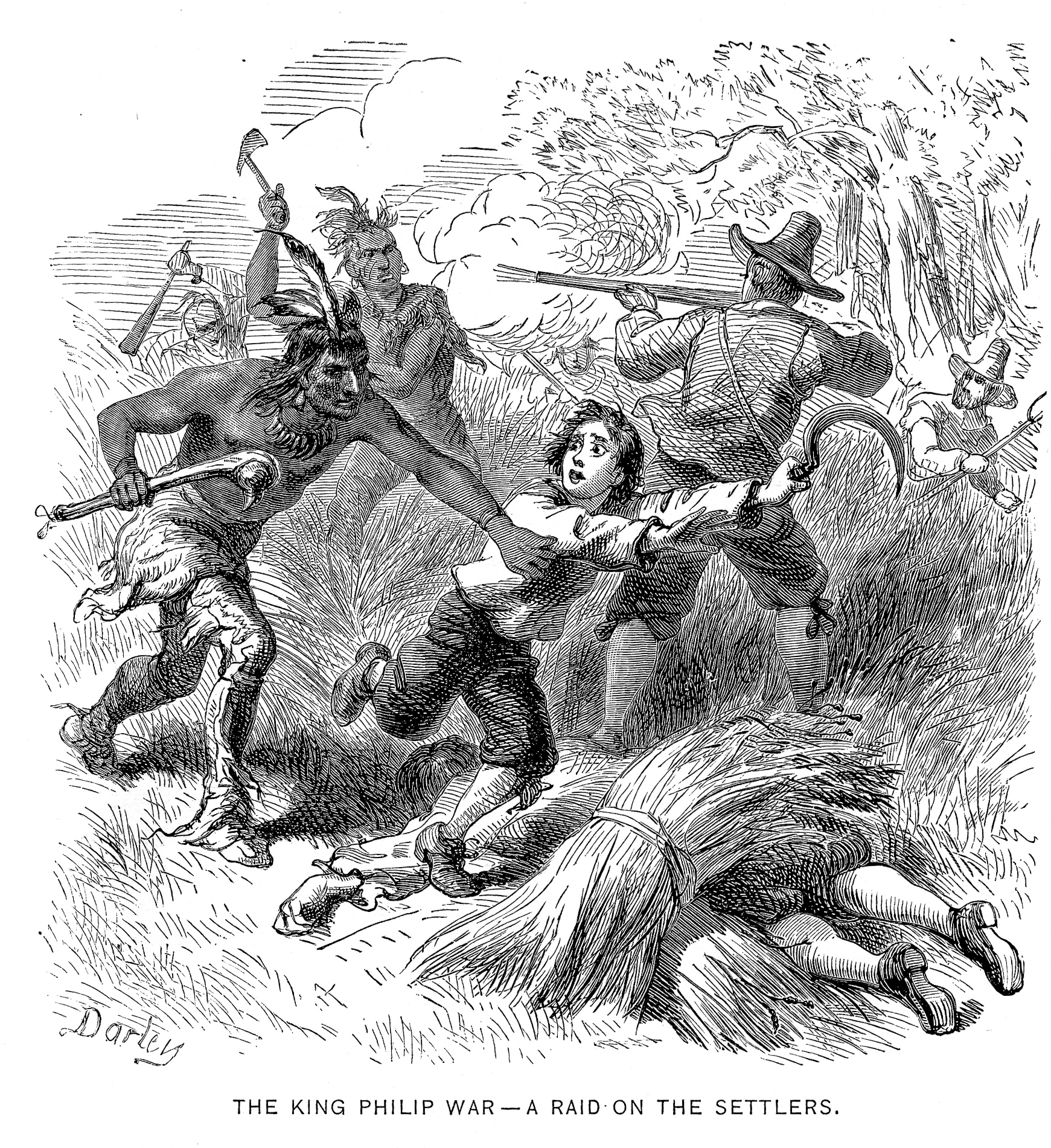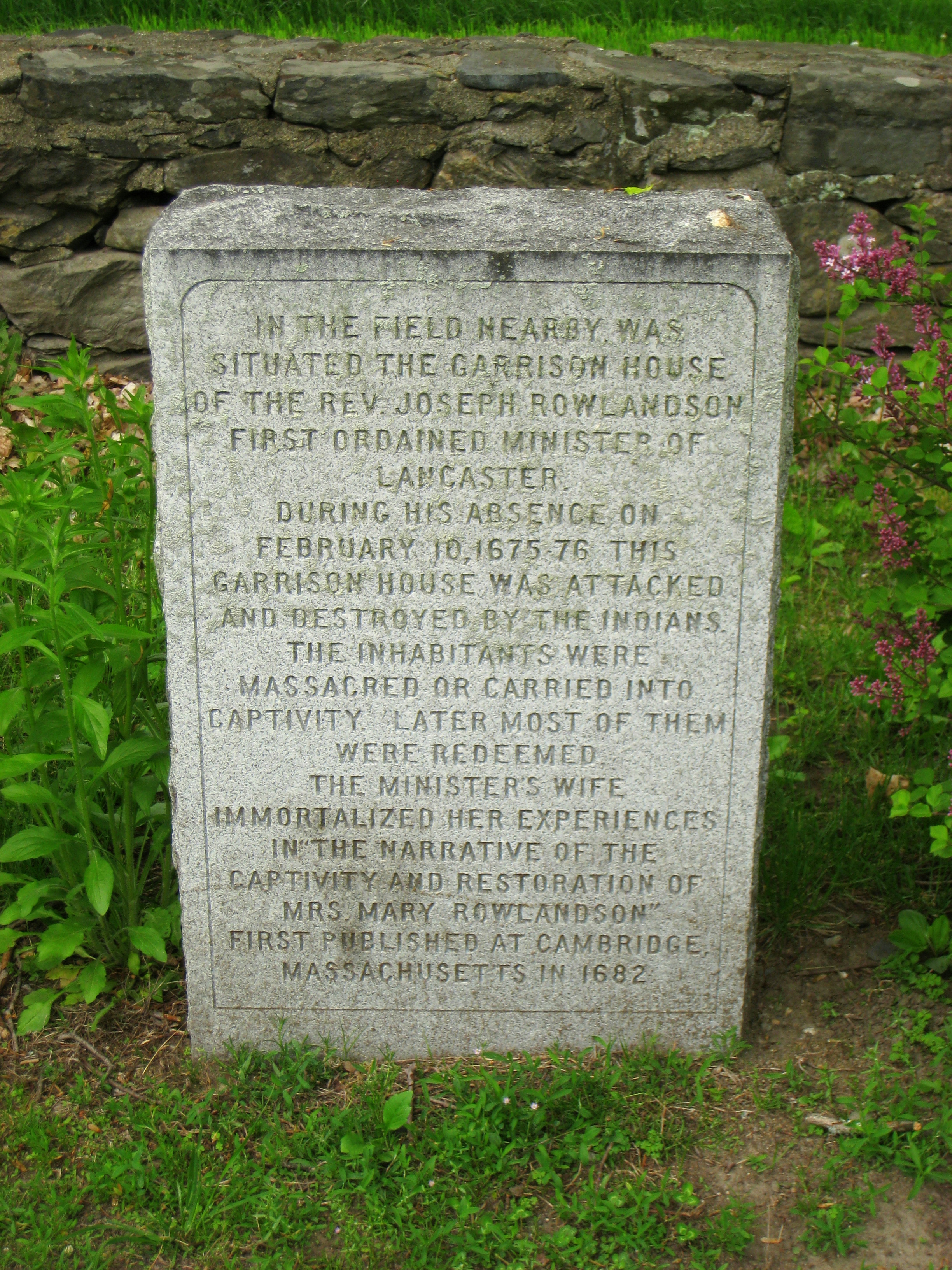Lancaster raid on:
[Wikipedia]
[Google]
[Amazon]
 The Lancaster Raid was the first in a series of five planned raids on English colonial towns during the winter of 1675-1676 as part of
The Lancaster Raid was the first in a series of five planned raids on English colonial towns during the winter of 1675-1676 as part of
 After the raid, the medicine man,
After the raid, the medicine man,
 After her release, she wrote a memoir of this period that was published in 1682. It is considered one of the genre of
After her release, she wrote a memoir of this period that was published in 1682. It is considered one of the genre of
 The Lancaster Raid was the first in a series of five planned raids on English colonial towns during the winter of 1675-1676 as part of
The Lancaster Raid was the first in a series of five planned raids on English colonial towns during the winter of 1675-1676 as part of King Philip's War
King Philip's War (sometimes called the First Indian War, Metacom's War, Metacomet's War, Pometacomet's Rebellion, or Metacom's Rebellion) was an armed conflict in 1675–1676 between indigenous inhabitants of New England and New England coloni ...
. Metacom
Metacomet (1638 – August 12, 1676), also known as Pometacom, Metacom, and by his adopted English name King Philip,Wampanoag
The Wampanoag , also rendered Wôpanâak, are an Indigenous people of the Northeastern Woodlands based in southeastern Massachusetts and historically parts of eastern Rhode Island,Salwen, "Indians of Southern New England and Long Island," p. 1 ...
sachem who led and organized Wampanoag warriors during the war. Teaming up with Nipmuc
The Nipmuc or Nipmuck people are an Indigenous people of the Northeastern Woodlands, who historically spoke an Eastern Algonquian language. Their historic territory Nippenet, "the freshwater pond place," is in central Massachusetts and nearby part ...
and Narragansett warriors, the Wampanoag successfully raided the town of Lancaster, securing provisions and prisoners to help them carry on into their winter offensive.
Mounting tension
The Lancaster Raid was preceded by several years of mounting tension between English colonists in Lancaster and their Native American neighbors, particularly those inNashaway The Nashaway (or Nashua or Weshacum) were a tribe of Algonquian Indians inhabiting the upstream portions of the Nashua River valley in what is now the northern half of Worcester County, Massachusetts, mainly in the vicinity of Sterling, Lancaster ...
. This tension stemmed from the decline in the fur trade due to overhunting, the dramatic decrease in the native population and social disruption due to European endemic diseases, and the competition for resources as English livestock invaded Indian lands. In 1675, the Wampanoag sachem Metacom cited his grievances as, "English cheating, discrimination, and pressures to sell land, submit to Plymouth colony's authority, convert to Christianity, and consume alcohol". To relieve tensions and ensure loyalty, Daniel Gookin
Major-General Danyell “Daniel” Gookin (1612 – 19 March 1687) was a Munster colonist, settler of Virginia and Massachusetts, and a writer on the subject of American Indians.
Early life
He was born, perhaps in County Cork, Ireland, in the ...
, the superintendent of Christian Indians, traveled to Nipmuc villages to establish praying towns
Praying towns were a settlements established by English colonial governments in New England from 1646 to 1675 in an effort to convert local Native Americans to Christianity.
The Native people who moved into these towns were known as Praying I ...
and convert the inhabitants to Christianity
Christianity is an Abrahamic monotheistic religion based on the life and teachings of Jesus of Nazareth. It is the world's largest and most widespread religion with roughly 2.38 billion followers representing one-third of the global pop ...
. However, the Nipmuc in Nashaway, unlike in many other towns, did not agree to become a praying town due to their intense distrust of the English and their missionaries.
Attack on Lancaster, 1675
Tensions continued to escalate until August 1675, when the Nipmuc from Nashaway staged an attack on Lancaster colonists, led by their sachem Monoco. Seven inhabitants of Lancaster died during the attack. For better defense, Lancaster built several garrison houses, large structures in which many colonists would gather during times of military strife, protected by fourteen stationed soldiers. After this, the war continued to spread westward, with the varied Indians staging many attacks on different English towns.Spies sent
The Lancaster Raid, commonly reapresented s a surprise attack, was not entirely a surprise. In December 1675, Daniel Gookin and the other leaders of the Massachusetts Council recruited two Christian Nipmuc men, James Quannapohit and Job Kattenanit, to act as spies. They were sent to gather information about other groups of Native Americans' loyalties and plans of attack against the English settlements. Traveling with the Nipmuc, the spies discovered that both the Narragansett and Nipmuc were planning to join Metacom's Wampanoag warriors to "burn and destroy the other frontier towns". The spies, Quannapohit and Kattenanit, were eventually found out and threatened by Metacom, so they fled. They split up, with Quannapohit the first to return toCambridge
Cambridge ( ) is a College town, university city and the county town in Cambridgeshire, England. It is located on the River Cam approximately north of London. As of the 2021 United Kingdom census, the population of Cambridge was 145,700. Cam ...
on January 24, 1676, reporting to Gookin that the Nipmuc were planning an attack on Lancaster.
Kattenanit's report
Despite Quannapohit's warning, the leaders of the Massachusetts Council did not take the threat seriously, and did little to prepare Lancaster for attack. They likely did not trust Quannapohit's warning or had larger threats to consider at the time. Several men from Lancaster took the threat more seriously, and traveled to Boston to try to recruit more troops for Lancaster, but to no avail. On February 9, Kattenanit reached Cambridge and also warned the Council of the threat, saying it was planned for the following day. Kattenanit reported that an attacking group of four hundred warriors had set out for Lancaster. By then, the Massachusetts Council ordered garrisons from other towns to aid Lancaster. But only Marlborough received word by the next morning, and their forces were unable to reach Lancaster until after the Indians had raided and set the town on fire.Lancaster Raid occurs
The Lancaster Raid took place on February 10, 1676. The Native American forces numbered 400, made up of Narragansett, Nipmuc, and Wampanoag warriors. As in the August 1675 attack, Monoco (Nipmuc at Nashaway), known as "One-Eyed John" by the English, led the raid. After they reached the town, the Indian forces burned the entry bridge, preventing access by outside English reinforcements could not easily enter. Once in town, they used torches to light houses on fire, including the garrisoned house of the village minister, Joseph Rowlandson. He had been one of the men who traveled to Boston seeking reinforcements, and had not yet returned. Most of the soldiers in the garrison survived the fire and were taken as prisoners. A few soldiers died in the fire, among an estimated fourteen Lancaster inhabitants lost. Twenty-three persons were taken captive, including women and children. The arrival of Marlborough troops forced the Indians to withdraw with their new captives. After the raid, the medicine man,
After the raid, the medicine man, Tantamous
Tantamous (also known as Old Jethro or John Jethro) (c. 1580–1676) was a well-known Native American Nipmuc leader in seventeenth century Massachusetts. Tantamous was a powwow ( healer and spiritual leader) who lived near the Assabet River,Barr ...
(Old Jethro), and ten other Nipmuc were falsely accused of the killings, allegedly due to their "singing, dancing, and having much powder and many bullets and slugs hid in their baskets." They were acquitted after the role of the sachem Monoco was discovered. In addition, Peter Jethro
Peter may refer to:
People
* List of people named Peter, a list of people and fictional characters with the given name
* Peter (given name)
** Saint Peter (died 60s), apostle of Jesus, leader of the early Christian Church
* Peter (surname), a su ...
, Tantamous's son, aided the settlers by communicating with the captors of Mary Rowlandson
Mary Rowlandson, née White, later Mary Talcott (c. 1637January 5, 1711), was a colonial American woman who was captured by Native Americans in 1676 during King Philip's War and held for 11 weeks before being ransomed. In 1682, six years after h ...
to obtain her release.
Mary Rowlandson taken captive
Mary Rowlandson
Mary Rowlandson, née White, later Mary Talcott (c. 1637January 5, 1711), was a colonial American woman who was captured by Native Americans in 1676 during King Philip's War and held for 11 weeks before being ransomed. In 1682, six years after h ...
, the village minister's wife, survived the fire along with three of her children, one of whom shortly died. She was held as a prisoner for nearly three months, separately from her children, and was forced to travel with the raiding bands.
 After her release, she wrote a memoir of this period that was published in 1682. It is considered one of the genre of
After her release, she wrote a memoir of this period that was published in 1682. It is considered one of the genre of captivity narrative
Captivity narratives are usually stories of people captured by enemies whom they consider uncivilized, or whose beliefs and customs they oppose. The best-known captivity narratives in North America are those concerning Europeans and Americans ta ...
s. She described herself as a servant to Quinnapin, a Narragansett sachem. Historians believe she likely was an adopted member of the household with an ambiguous status, and expected to work. Although required to perform seamstress work and other chores, Mary was treated relatively kindly by Quinnapin and Metacom, likely because of her high status among colonial society and her high political and economic value as a hostage.
She complained chiefly of abuse by Quinnapin's wife, Weetamoo
Weetamoo (c. 1635–1676), also referred to as Weethao, Weetamoe, Wattimore, Namumpum, and Tatapanunum, was a Pocasset Wampanoag Native American Chief. She was the ''sunksqua'', or female sachem, of Pocasset tribe, which occupied contempora ...
, who demanded Mary's subservience. Eventually many of the captives were ransomed and returned home, such as Rowlandson, Mrs. John Kettell
John Kettell (c.1639-c.1676 or 1685 or c.1690) (also known as John Kettle) was an early settler, cooper, and explorer in what is Maynard, Massachusetts and Stow, Massachusetts. Kettell's family was taken captive by Native Americans in King Phil ...
, and others.Rex, Cathy (March 2011). "Indians and Images: The Massachusetts Bay Colony Seal, James Printer, and the Anxiety of Colonial Identity". ''American Quarterly''. 63 (1): 61.
Lancaster abandoned
The town of Lancaster was devastated after the raid. In addition to having buildings destroyed, the townspeople had lost their food stores to the raiders, in the middle of winter. They were vulnerable to another attack and dependent on receiving food supplies. Many survivors left town by way of carts sent by the General Court in March 1676, and the town was mostly abandoned.References
{{Coord, 42.4534, -71.6734, display=title 1676 in Massachusetts 1676 in the Thirteen Colonies Battles in Massachusetts Lancaster Lancaster History of Worcester County, Massachusetts King Philip's War Lancaster, Massachusetts